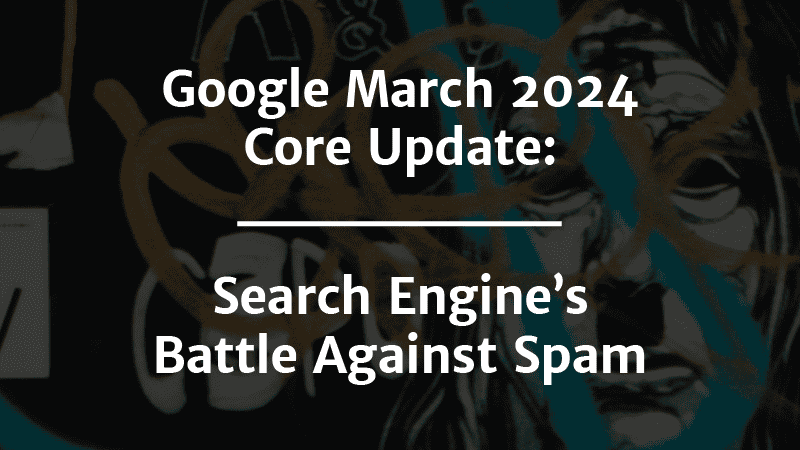If you write or manage search engine optimized (SEO) content and aren’t following the principles of inclusive writing, you could be missing out on the opportunity to communicate effectively with diverse audiences.
After all, everyone likes to read something they feel is written just for them.
Sure, you’ve probably made assumptions about your audience to try and reach them.
However, if you fail to write in a way that includes a diverse audience, you could damage your brand.
Inclusive writing helps ensure your target audience feels welcomed instead of ignored (or, worse — offended) by your brand’s message. It also empowers you to reach a wider audience, building engagement with your content and brand.
Even if you haven’t heard of inclusive language until now, you’ve likely seen it in action. It’s become so important to writing that almost all major modern style guides have sections on it.
What’s more, many top content writing agencies have followed suit. For example, here at The Blogsmith, we’ve written comprehensive internal and external style guides that hammer home the importance of inclusive writing.
Still not convinced that you need to consider creating an inclusive language style guide?
In its 2022 study on global marketing trends, Deloitte found that 57% of consumers are more loyal to brands committed to addressing social inequities.
However, inclusive language isn’t about following the latest trend.
By using inclusive language (instead of exclusive language), you acknowledge the diversity of human experiences and show due consideration for others.
You could be forgiven for thinking that inclusive writing is about including every human experience in your written content.
Instead, think of it as helping to make sure no one feels excluded or hurt when they read something you’ve written.
Language has the power to divide individuals, but it also has the power to unite them.
Here’s what you’ll learn in this guide to inclusive writing:
Inclusive Language 101
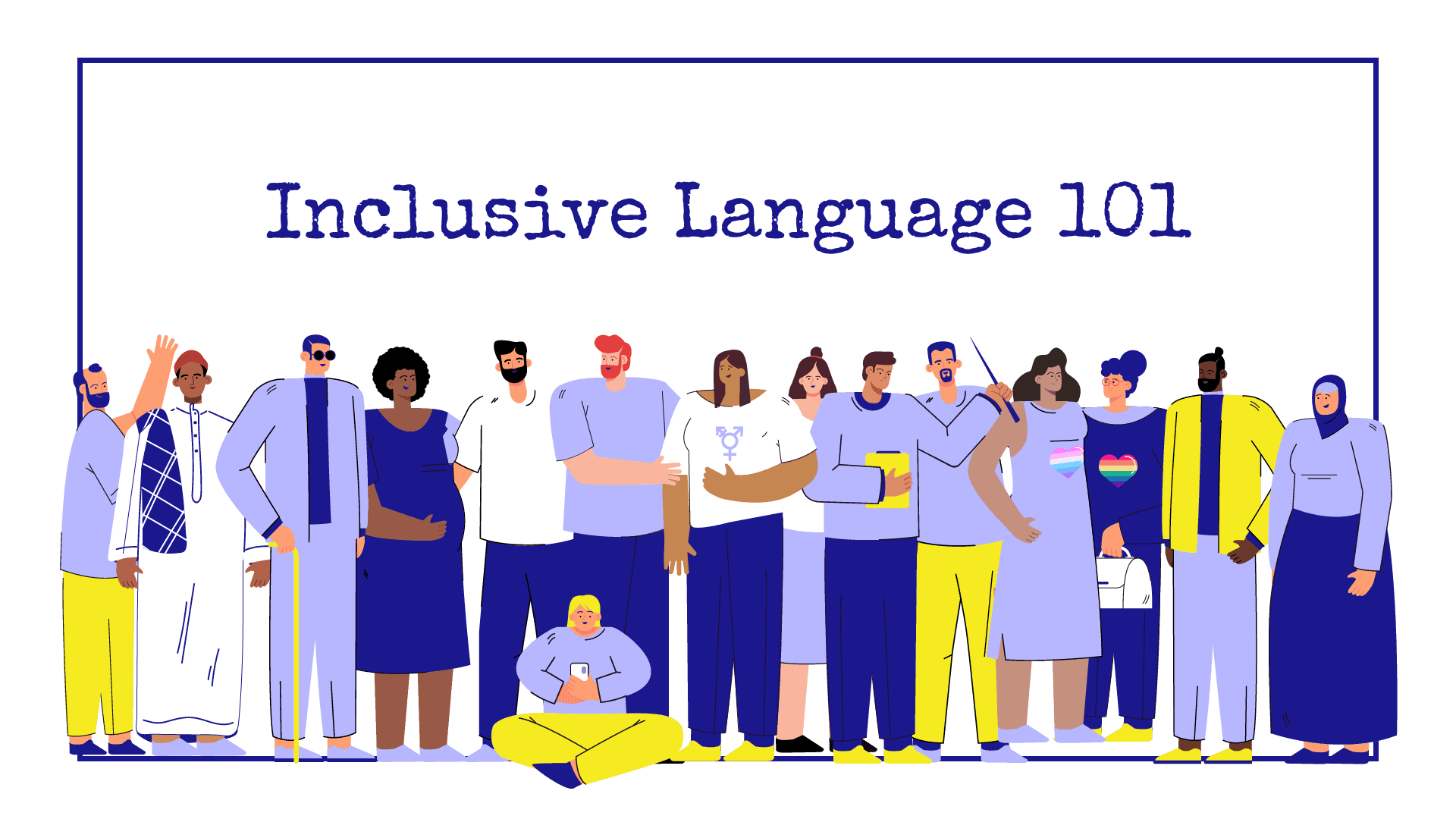
Ever thought you knew what a word or phrase meant, only for the dictionary to rain on your parade? You’re certainly not alone.
Here’s how Collins Online Dictionary defines inclusive language:
“Language that avoids the use of certain expressions or words that might be considered to exclude particular groups of people, especially gender-specific words, such as ‘man,’ ‘mankind,’ and masculine pronouns, the use of which might be considered to exclude women.”
You’ll notice a few things about this definition. First, the focus is on avoiding words that exclude certain individuals rather than trying to include the experience of every individual. Second, it focuses on gender-inclusive language.
Although this dictionary definition is helpful, to succeed at inclusive writing, you’ll want to consider more than just gendered language use.
The internet brings large, diverse groups of people together, and that can lead to misunderstandings. Even in a group of people sharing commonalities, individuals within it likely self-identify in different ways.
When striving to ensure your writing is inclusive, start by reminding yourself that members of your audience differ in terms of:
- Gender and gender identity
- Ethnicity
- Culture
- Sexual orientation
- Religious affiliations
- Disability status
- Mental health status
- Age
- Socioeconomic status
These examples aren’t exhaustive. However, they can serve as a jumping-off point for inclusive writing.
Remember that this type of writing shouldn’t be tokenistic. When you write any type of content, keeping the goals of inclusive writing in mind can be the best way of ensuring your writing doesn’t exclude or offend particular individuals or groups.
The main goals of inclusive writing are to:
- Include rather than exclude.
- Communicate with individuals based on a shared humanity.
- Help all groups and individuals feel empowered, not marginalized.
- Build trust with your audience.
- Ensure your audience feels comfortable reading your content.
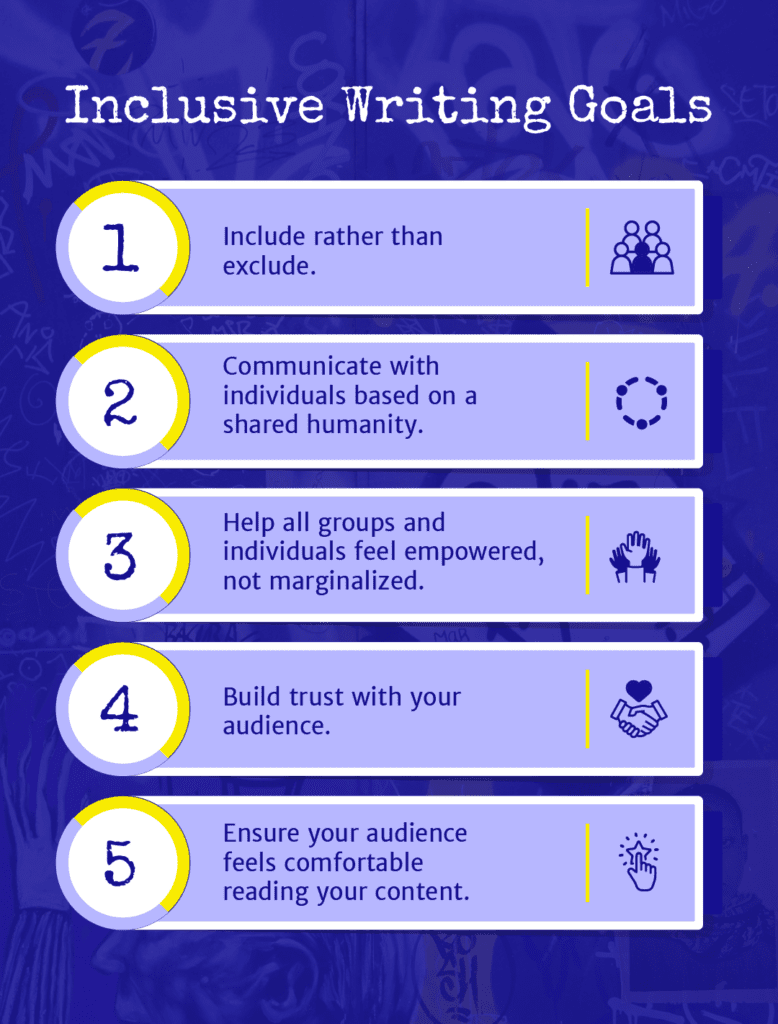
Common Barriers to Inclusive Writing
Inevitably, you’ll face barriers to inclusive writing. Language evolves constantly, and you must take initiative and change with it as a content writer or marketing manager.
For example, you might have changed your writing approach to ensure you cater to both search engines and humans.
But when it comes to inclusive writing, you may face resistance from your team.
Undoubtedly, our personal biases influence our word choice. You may have picked up stereotypes from society and culture, or you may have even used a phrase that you didn’t know had a negative connotation to a specific group.
Many personal biases are so ingrained that we don’t even recognize them without deliberate introspection.
When you tell people to change their language, they may feel attacked and push back. Their own fears often drive this because they don’t truly understand what inclusive language is.
But team training in inclusive language plus an inclusive language style guide can help.
As language evolves with society, you’ll notice that some words or phrases previously considered acceptable are now viewed differently.
When you read the history of some of these words and phrases, you’ll agree that some now come across as harsh. Others are extremely offensive.
Atlassian’s inclusive language style guide can give you some useful examples of phrases that are offensive to certain groups of people, along with practical alternatives.
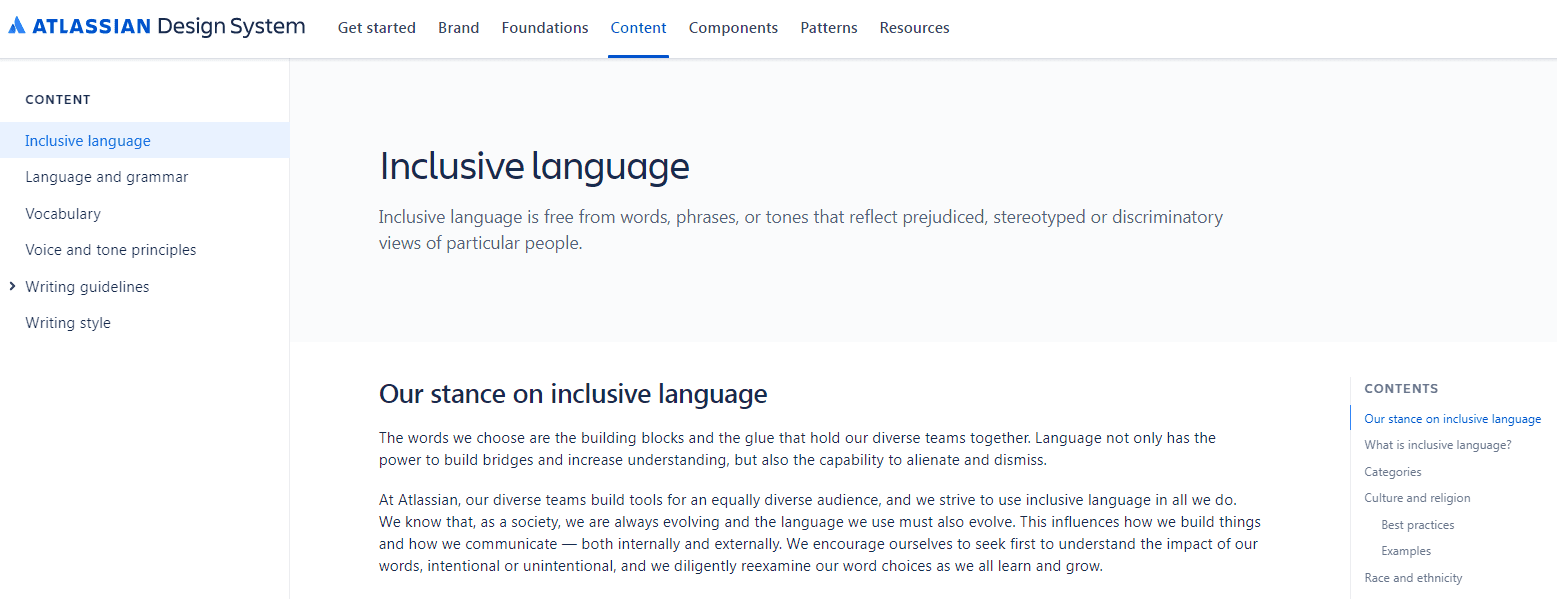
Realistically, it probably isn’t feasible for you to learn the history of every phrase — though an inexhaustive study of languages and the roots of words can certainly be interesting. However, by carefully considering the words you use, you can make a difference in how diverse readers respond to your marketing content.
Inclusive Language Style Guide
- Does your content serve your audience?
- Do the references to people reflect the diversity of your audience?
- Are you using any problematic words or phrases?
- How do you use personal pronouns?
- What is gender-inclusive writing?
- How do you know if you are using discriminatory language?
It’s never too late to get started creating your brand’s inclusive language style guide (you can also call it a conscious style guide or diversity style guide).
But what if you don’t have an in-house style guide either? You can always create a standalone inclusive language style guide or build a general style guide with an inclusive language section.
By creating a style guide and making sure all your team members are on the same page, you’ll be able to improve the quality and consistency of your online content.
And when you add an inclusive language section to your style guide, you can help team members better understand the overall concepts of inclusive writing. They’ll also find it easier to avoid non-inclusive terms they might not have realized were problematic while staying true to your company voice.
However, you shouldn’t just copy the framework of other inclusive writing style guides and hope they apply to your business.
An inclusive language style guide is much more than just listing words to avoid.
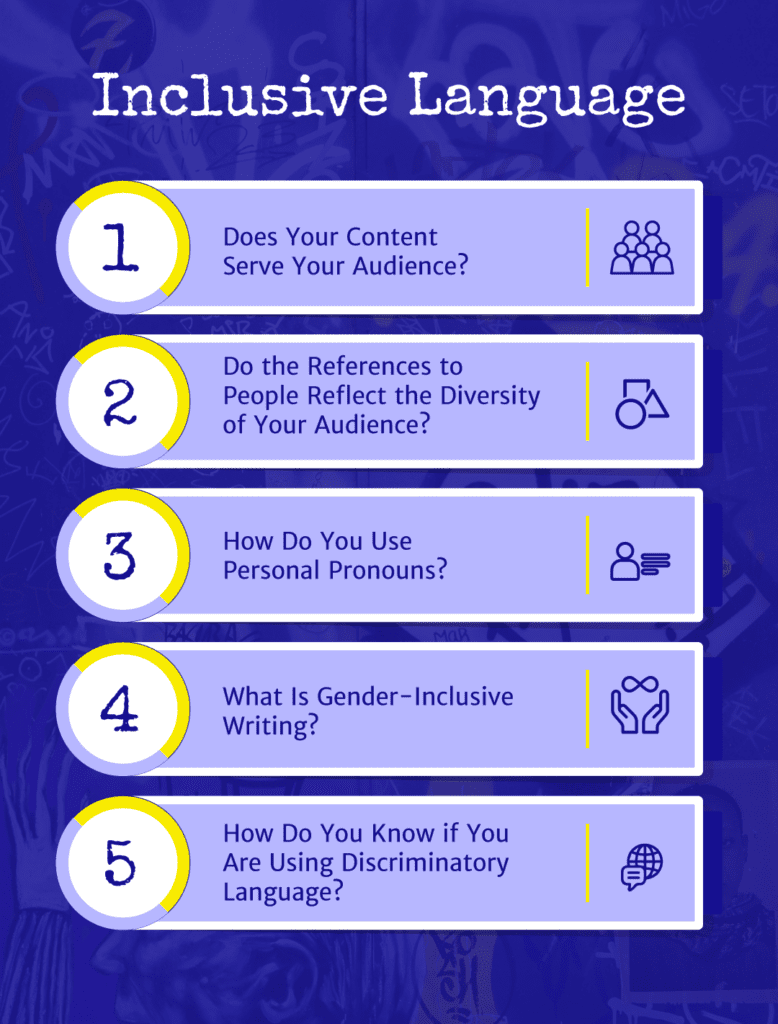
These questions can help you target your inclusive writing needs:
Does Your Content Serve Your Audience?
As a content writer or manager, you want to make sure your work feels relevant to all members of your audience.
In defining your audience, you likely made some assumptions about who they are beyond basic demographics.
But demographics don’t tell the whole story. Does the language you use engage your audience in a way that’s inclusive?
Your readers could be from disadvantaged or underrepresented groups. For this reason, the pain points your writing addresses shouldn’t be exclusive to privileged groups.
For example, if you’re writing an article about the best tips to get rid of mold from walls, you shouldn’t assume all your readers are homeowners.
Stereotypes linger in society and continue to cause harm in many ways. Make sure your writing doesn’t perpetuate stereotypes and alienate your diverse customer base.
Also, it’s important to note that inclusive writing is about more than just catering to your target audience. It’s about being a good global citizen and not making anyone — within your audience or not — feel unintentionally alienated by your language choice.
The words you choose reflect your brand as a whole. You don’t have to cater to those outside your audience, but your language shouldn’t make them uncomfortable, either.
Do the References to People Reflect the Diversity of Your Audience?
To nail inclusive writing, make sure the references you use don’t exclude certain individuals.
For example, if you’re writing a blog about the challenges of caring for newborns, the noun “parental leave” is a more inclusive option than “maternity leave.” If you opt to use “maternity leave,” you could accidentally alienate a wide audience of parents.
Understanding the makeup of your audience beyond traditional roles and stereotypes is vital as part of creating your inclusive language content pieces.
If you haven’t already, you should consider making changes to how you address your readers to ensure that diverse audiences feel heard. Take the time to examine your current content with a critical eye, looking for stereotypes and excluding language and descriptors.
Are You Using Any Problematic Words or Phrases?
You may have read that many historical terms and phrases are problematic, but you should also be aware that even modern terminology can be othering.
Many words and phrases are so common to our habitual language that we may not even realize there is a potential problem. Having an inclusive language style guide helps your team quickly double-check their terminology for problem phrases.
For example, “grandfathered in” or “grandfather clause” is very common in writing about laws, contracts, zoning, HOAs (homeowner associations), and even health insurance.
But the phrases came from a set of voting laws created in some American states during the country’s Jim Crow era that were designed to suppress African American votes. More inclusive alternatives include “exempted” or “legacied.”
How Do You Use Personal Pronouns?
Personal pronouns are important to a person’s gender expression and identity. For this reason, you should avoid using pronouns based only on assumptions about the gender of your audience.
If you’re writing about a specific individual, always double-check to make sure you’re using their preferred pronoun(s).
For example, many people list their preferred pronouns on their social media profiles (like LinkedIn) or personal website. If there’s any doubt, ask the individual what their preferences are.
One approach is to use gender-neutral pronouns such as “they/them” instead of “he/him” and “she/her.”
Various authorities on writing style also support the use of singular “they,” including the American Psychological Association (APA).
What Is Gender-Inclusive Writing?
It’s important to use language that includes rather than assumes gender. Inclusive writing acknowledges gender diversity. That includes people who identify as transgender, cisgender, non-binary, and/or among many other gender identities in the world.
You aren’t expected to know everything. However, if you notice that words you’ve used don’t seem gender-neutral, think about using substitutes to ensure your writing speaks to all genders.
Here are some examples of substitutions for gendered terms:
Gendered term | Inclusive alternative |
Manpower | Personnel |
Chairman | Chairperson |
Policeman | Police officer |
How Do You Know if You Are Using Discriminatory Language?
If you think the language you’re using in content writing could be discriminatory toward certain groups, that’s a good sign you should do some research before continuing.
Views on certain words and phrases are constantly changing.
That’s why you should consider making your inclusive language style guide a living document that can be regularly updated by a team member who has received extensive diversity training.
If you aren’t in a position to do this, consider getting assistance from a content marketing agency to ensure your language isn’t offensive to readers.
Remember, individuals within groups will have different preferences and self-identities, so never assume one term is always preferred when working to ensure your writing is inclusive.
Final Thoughts: Benefits of an Inclusive Language Guide for SEO Writing
In the internet era, inclusive writing has changed how marketers think about the words they use. If you aren’t using inclusive language to reach diverse audiences, it’s time to get started.
Unsure of the first steps to take?
The best option to ensure your writing doesn’t exclude different individuals and groups is to create and maintain an inclusive language style guide.
The Blogsmith Founder Maddy Osman provides helpful tips on how to create an inclusive language style guide in her best-selling book, “Writing for Humans and Robots: The New Rules of Content Style.”
Plus, The Blogsmith’s team of writers and editors ensure that all published content follows the principles of inclusive writing.
Get in touch today to find out how The Blogsmith can help you publish engaging SEO marketing content using inclusive language.






